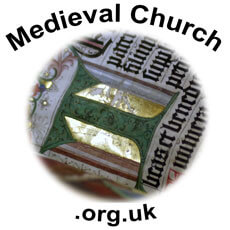Hussites
Theology on the Web helps over 2.5 million people every year to find high quality theological resources that will help to equip them to serve God and to know Him better (2 Timothy 2:15). Like other websites that provide free services, it is dependent on donations to enable it to grow and develop and only 0.004% of visitors currently do so. If you would like to support this site, please use one of the options to the right of this message.
Synopsis
HUSSITES, the Bohemian followers of John Hus. The execution of Hus excited intense feeling in Bohemia and Moravia; and it was no wonder that some of the reformer’s enemies among the priests were stabbed, or thrown into the Moldau, and that the archbishop himself barely escaped the wrath of the infuriated populace. The king, Wenceslaus, tried to maintain a neutral attitude between both parties. But in September, 1415, a large assembly was held, at which four hundred and fifty-two of the nobility signed a protest to the Council of Constance, and approved the doctrines of Hus. On the 5th they formed a league for mutual aid in religious concerns, binding themselves to protect the free preaching of God’s Word on their estates, and to recognize the edicts of prelates only so far as they accorded with the Scriptures.
The ecclesiastical party entered into a counter league; and the Council of Constance cited the nobles to appear before it, and even threatened (Feb. 24, 1416) Bohemia with a crusade. But the Hussites could not be so easily intimidated. Pope Martin V. inaugurated more energetic measures, and, after dissolving the council (April 22, 1418), determined to destroy the Bohemian heresy root and branch. Wenceslaus was persuaded in 1419 to move against it, and the Hussites at court were obliged to leave. On Aug. 16 the king died, but civil war had already begun.
What was the character of this Bohemian movement? First of all we are struck with the intense veneration for Hus. his followers, however, disavowed the name "Hussites," and wanted to be known as Catholic Christians. They were unanimous in regarding the Scriptures as the supreme authority in doctrine and life, but they split into two parties in the application of this principle. The radical wing, accepting only that which was expressly commanded in Scripture, rejected the doctrines of purgatory, the worship of saints, the use of a foreign tongue in public services, etc. The moderate wing accepted all ecclesiastical customs the Scriptures did not expressly forbid. They put forth the famous Four Prague Articles in Latin, Czech, and German, in July, 1420. These called for (1) the free preaching of God’s Word, (2) the distribution of the sacrament under two kinds, (3) the deprivation of the clergy of secular power and possessions which they used to the injury of their office and the state, and (4) the repression of mortal sins and public scandals. The moderate party was called the Praguers, and, later, Calixtines (from calix, "cup"), or Utraquists. They had at their head Baron Czenko of Wartenberg. The radicals acknowledged Nicholas of Pistnia and John Zizka as leaders, and were called Taborites, from the fortress of Tabor, sixty miles south of Prague, which they occupied.
From 1420 to 1425, Catholic Germany marched in crusades against the Hussites; hut the latter were victorious, and, from 1427 on, took the offensive against their enemies under the generalship of Procopius the Great. Cardinal Julian Cesarini, after the ignominious defeat of the last crusade, which he led Aug. 14, 1431, concluded, as president of the Basel Council, that the only way to put down the heresy was by conciliatory treatment. In October the council invited the Bohemians to appear before it. They refused until the delegates had conceded their main conditions at Eger. This was the first instance in the whole history of the Church for a council to treat upon an equal footing with a party demanding reforms. On Nov. 30, 1433, articles were agreed upon fully granting the administration of the communion in both kinds, and conceding the other points of the Prague Articles, but in a somewhat illusory manner.
The moderate party was satisfied, the Taborites not. Civil war broke out afresh; and the army of the latter was defeated in a decisive battle May 30, 1434. The Taborites gradually disappeared, or were lost, a generation or two later, in the Bohemian Brethren.
The articles of the Basel Council were confirmed by the National Bohemian Assembly at Iglau, July 5, 1436. But Pope Pius II., on March 31, 1462, declared them void, threatening with excommumcation all who administered the cup to the laity. The Utraquist party was not intimidated. In 1483 the king signed an agreement confirming the articles of Basel, and in 1512 the Bohemian Parliament granted to the Utraquists equal rights with the Catholics.
The Utraquists sent words of cheer to Luther (July 16, 1519), and with them Hus’s works, in which he was surprised to find his own doctrines taught. A portion only of the party fell in with the Reformation. In 1575 the Bohemian Parliament passed the Confessio Bohemica on the basis of the Augsburg Confession.
G.V. Lechler, "Hussites," Philip Schaff, ed., A Religious Encyclopaedia or Dictionary of Biblical, Historical, Doctrinal, and Practical Theology, 3rd edn, Vol. 2. Toronto, New York & London: Funk & Wagnalls Company, 1894. pp.1045-1046.
Bibliographies
| J.K. Zeman, The Hussite Revolution and the Reformation Bohemia, Moravia and Slovakia (1350-1650): A Bibliographical Study Guide (With Particular Reference to Resources in North America). Ann Arbor, Michigan, 1977. |
Secondary Sources
| F.M. Bartos, The Hussite Revolution, 1424-1437. Columbia University Press, 1986. Hbk. ISBN: 088033097X. pp.204. | |
| Peter Brock, The Political and Social Doctrines of the Unity of the Czech Brethren in the Fifteemth and Sixteenth Centuries. Wiesbaden: Otto Harrassowitz, 1958. pp.302. | |
| Thomas A. Fudge, "The State of Hussite historiography," Mediaevistik 77 (1994): 93-117. | |
| Thomas A. Fudge, The Magnificent Ride: The First Reformation in Hussite Bohemia. St. Andrews Studies in Reformation History. Aldershot & Brookfield: Ashgate Publishing Limited, 1998. Hbk. ISBN: 1859283721. pp.336. | |
| F.G. Heymann, "The Hussite-Utraquist Church in the fifteenth and sixteenth centuries," Archiv für Reformationgeschichte 52 (1961): 1-26. | |
| F.G. Heymann, "The Hussite-revolution and the German Peasants' War: an historical comparison," Medievalia et Historica, n.s. 1 (1971): 141-59. | |
| R. Kalivoda, "A new approach to the post Hussite development of Hussitism," Commonio Viatorum 27 (1984): 73-90. | |
| Howard Kaminsky, "Hussite radicalism and the origins of Tabor, 1415-1418," Medievalia et Hunanistica 10 (1956): 102-30. | |
| Howard Kaminsky, "Pius Aeneas among the Taborites," Church History 28 (1959): 281-309. | |
| Howard Kaminsky, "The religion of Hussite Tabor," M. Reichigl, ed., The Czechoslovak Contribution to World Culture. The Hague, 1964. pp.210-23. | |
| Howard Kaminsky, "Nicholas of Dresden and the Dresden School in Hussite Prague," H. Kaminsky et al, eds. Master Nicholas of Desden: The Old Color and the New, Transactions of the American Philosophical Society, n.s. 55, i. Philadelphia, 1965. pp.5.28. | |
| Howard Kaminsky, "The Prague Insurrection of 30 July 1419," Medievalia et Hunanistica 17 (1966): 106-26. | |
| Howard Kaminsky, A History of the Hussite Revolution. Berkeley & Los Angeles, CA: University of California Press, 1967. pp. xv + 580. | |
| Howard Kaminsky, The Hussite Revolution, T. Gottheinerova, translator. Prague, 1988. | |
| John Klassan, Nobility and the Making of the Hussite Revolution. Columbia University Press, 1978. Hbk. ISBN: 0914710400. | |
| John Klassen, Warring Maidens, Captive Wives and Hussite Queens. Columbia University Press, 1999. Hbk. ISBN: 0880334258. pp.306. | |
 Malcolm D. Lambert, Medieval Heresy:
Popular Movements from the Gregorian Reform to the Reformation , 3rd edn.
Oxford: Blackwell Publishers, 2002. Pbk. Blackwell Publishers; ISBN:
0631222766. pp.504. See chapters 16-19. Malcolm D. Lambert, Medieval Heresy:
Popular Movements from the Gregorian Reform to the Reformation , 3rd edn.
Oxford: Blackwell Publishers, 2002. Pbk. Blackwell Publishers; ISBN:
0631222766. pp.504. See chapters 16-19. |
|
 G.H.W. Parker, The Morning Star. Wycliffe and the Dawn of the Reformation. Exeter: The Paternoster Press, 1965. Hbk. pp.248. G.H.W. Parker, The Morning Star. Wycliffe and the Dawn of the Reformation. Exeter: The Paternoster Press, 1965. Hbk. pp.248. |
|
| M. Polivka, "Nicholas of Hus," Historica 28 (1988): 75-121. | |
| M. Polivka, "Popular movement as an agent of the Hussite revolution in late medieval Bohemia," J. Purs & K. Herman, eds, History and Society, Prague, 1985. pp.261-85. | |
| F. Smahel, "The idea of the 'nation' in Hussite Bohemia," Historica 16 (1969): 143-347; 17 (1969): 93-197. | |
 Murray L. Wagner, Petr Chelcicky: A
Radical Separatist in Hussite Bohemia. Herald Press, 1983. Hbk. ISBN:
0836112571. pp.212. Murray L. Wagner, Petr Chelcicky: A
Radical Separatist in Hussite Bohemia. Herald Press, 1983. Hbk. ISBN:
0836112571. pp.212. |
|
| J.K. Zeman, "The rise of religious liberty in the Czech reformation," Central European History VI (1973): 128-47. | |
| J K Zeman, ed. Hussite Movement and the Reformation in Bohemia, Moravia and Slovakia, 1350- 1650. Michigan Slavic Pubns, US, 1980. Hbk. ISBN: 093004200X. |
Related Subjects
Bohemian Brethren | Orebites | Taborites | Unitas Fratrum
 |
|
 |
|
 |
Heresies | Alogi | Apollinarianism | Arianism | Docetism | Donatism | Gnosticism | Manicheaism | Marcion | Monarchianism | Montanism | Nestorianism | Pelagianism |








